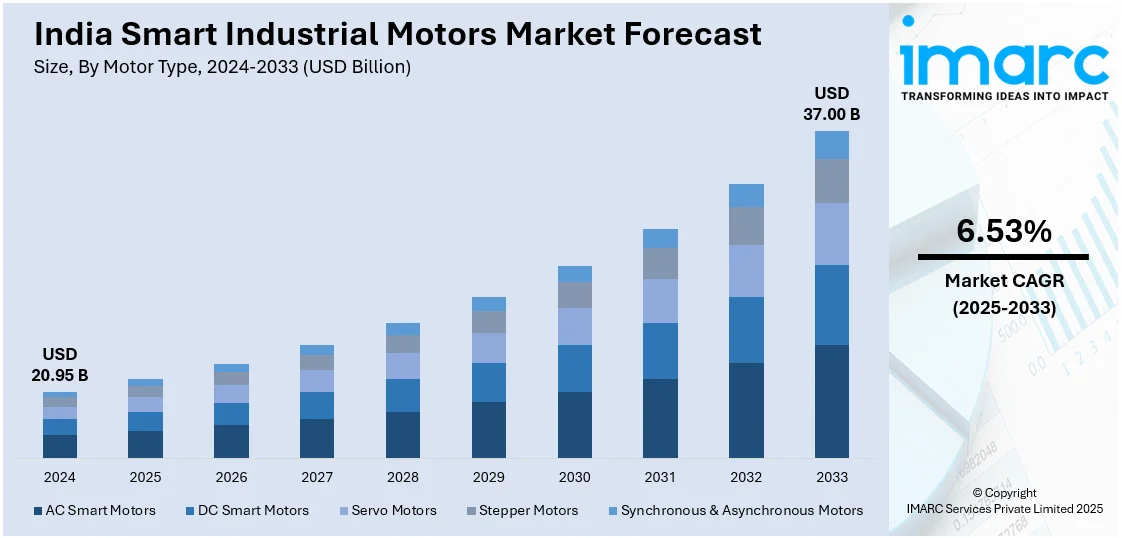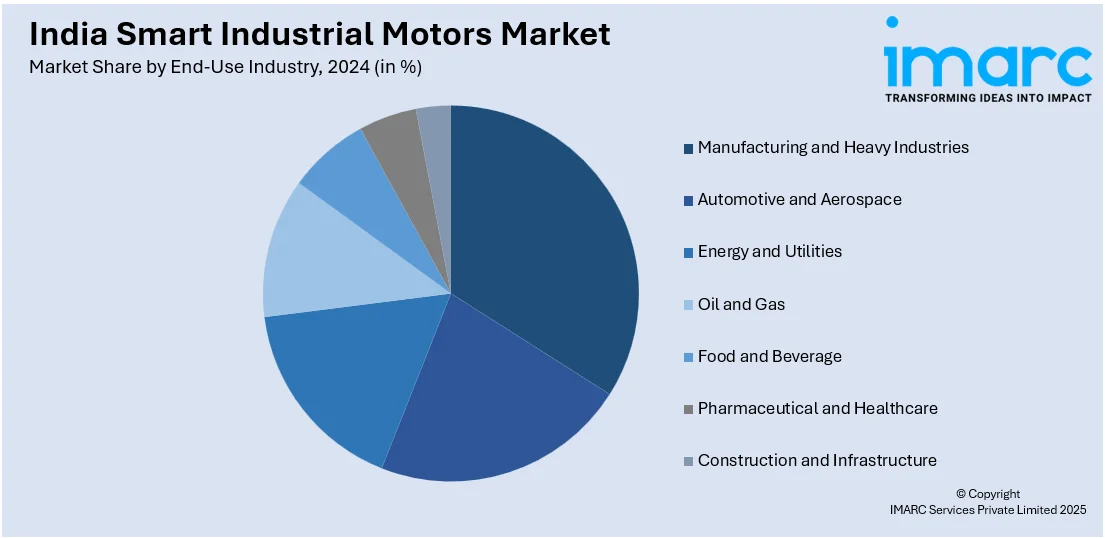
India Smart Industrial Motors Market Size, Share, Trends and Forecast by Motor Type, Connectivity & Intelligence, Power Rating, End-Use Industry, and Region, 2025-2033
India Smart Industrial Motors Market Overview:
The India smart industrial motors market size reached USD 20.95 Billion in 2024. Looking forward, IMARC Group expects the market to reach USD 37.00 Billion by 2033, exhibiting a growth rate (CAGR) of 6.53% during 2025-2033. The growth of the market is driven by rising Industry 4.0 adoption, IoT-enabled predictive maintenance, and stringent energy efficiency regulations. Government initiatives such as Make in India and incentives for energy-efficient technologies further enhance demand. Industries are shifting to smart motors to reduce operational costs, minimize downtime, and comply with sustainability norms, further expanding the India smart industrial motors market share.
|
Report Attribute
|
Key Statistics
|
|---|---|
|
Base Year
|
2024 |
|
Forecast Years
|
2025-2033
|
|
Historical Years
|
2019-2024
|
| Market Size in 2024 | USD 20.95 Billion |
| Market Forecast in 2033 | USD 37.00 Billion |
| Market Growth Rate 2025-2033 | 6.53% |
India Smart Industrial Motors Market Trends:
Rising Adoption of IoT-Enabled Smart Motors for Predictive Maintenance
The market is witnessing an increase in demand for IoT-enabled motors due to their predictive maintenance capabilities. Businesses are adopting sensors and connectivity solutions to monitor motor performance data in real time to avoid unexpected downtimes and maintenance expenses. Smart sensors will enable intelligent motors to monitor vibration, temperature, and consumed energy to permit AI analytics or comparison to prior or historic data for the ability to forecast failures that will occur prior to actuality. Manufacturing, oil and gas, and automobile industries have taken the forefront of this drive toward operational efficiencies and cost reductions. Government initiatives such as Make in India and the push for Industry 4.0 are further supporting the India smart industrial motors market growth. India's manufacturing sector is quickly embracing Industry 4.0 technologies, with machine learning and artificial intelligence expected to reach 40% of total manufacturing spending by 2025 compared to 20% in 2021. Thus, the demand for smart industrial motors will increase in line with the preponderance of smart factories, enabling automated machinery to achieve both efficiency and precision. As businesses prioritize automation and data-driven decision-making, the demand for smart industrial motors with IoT integration is expected to grow significantly over the next five years.

To get more information on this market, Request Sample
Energy Efficiency Regulations Driving Demand for Smart Motors
The rigorous energy efficiency policies emerging in India are contributing to pushing the utilization of smart industrial motors. There are various standards currently being put in place by government bodies, notably the Bureau of Energy Efficiency (BEE), for newly designed electric motors demanding higher efficiency. Smart industrial motors refer to electric motors that employ a Variable Frequency Drive (VFD) and advanced control algorithms to adjust their energy consumption levels according to working needs such as load. Sectors are replacing conventional electric motors with smart motors more and more in order to meet this regulatory environment. The cost of electricity is another motive to switch to smart motors. The government also offers incentives and discounts to promote the use of energy-efficient technologies. The Union Ministry of Power announced plans to launch a INR 1,000 crore (approximately USD 118.1 Million) incentive scheme for enhancing energy efficiency in small and medium-sized enterprises (SMEs) that will give an interest subvention of up to 5% for implementing energy-efficient technology. The initiative, under the Bureau of Energy Efficiency's ADEETIE, will support technologies including automation, combustion control, and methane capture. This program aligns with India's overall sustainability goals, which aim to reduce emissions and enhance energy efficiency in the manufacturing sector. With rising energy costs and sustainability goals, manufacturers are investing in smart motor solutions, making energy efficiency a key driver in the Indian market’s growth.
India Smart Industrial Motors Market Segmentation:
IMARC Group provides an analysis of the key trends in each segment of the market, along with forecasts at the country and regional levels for 2025-2033. Our report has categorized the market based on motor type, connectivity & intelligence, power rating, and end-use industry.
Motor Type Insights:
- AC Smart Motors
- DC Smart Motors
- Servo Motors
- Stepper Motors
- Synchronous & Asynchronous Motors
The report has provided a detailed breakup and analysis of the market based on the motor type. This includes AC smart motors, DC smart motors, servo motors, stepper motors, and synchronous & asynchronous motors.
Connectivity & Intelligence Insights:
- IoT-Enabled Smart Motors
- AI & ML-Integrated Motors
- Wireless & Cloud-Connected Motors
- Edge Computing & Embedded Systems in Motors
A detailed breakup and analysis of the market based on the connectivity & intelligence have also been provided in the report. This includes IoT-enabled smart motors, AI & ML-integrated motors, wireless & cloud-connected motors, and edge computing & embedded systems in motors.
Power Rating Insights:
- Low Power (0.1 kW - 10 kW)
- Medium Power (10 kW - 100 kW)
- High Power (Above 100 kW)
The report has provided a detailed breakup and analysis of the market based on the power rating. This includes low power (0.1 kW - 10 kW), medium power (10 kW - 100 kW), and high power (Above 100 kW).
End-Use Industry Insights:

- Manufacturing and Heavy Industries
- Automotive and Aerospace
- Energy and Utilities
- Oil and Gas
- Food and Beverage
- Pharmaceutical and Healthcare
- Construction and Infrastructure
A detailed breakup and analysis of the market based on the end-use industry have also been provided in the report. This includes manufacturing and heavy industries, automotive and aerospace, energy and utilities, oil and gas, food and beverage, pharmaceutical and healthcare, and construction and infrastructure.
Regional Insights:
- North India
- South India
- East India
- West India
The report has also provided a comprehensive analysis of all the major regional markets, which include North India, South India, East India, and West India.
Competitive Landscape:
The market research report has also provided a comprehensive analysis of the competitive landscape. Competitive analysis such as market structure, key player positioning, top winning strategies, competitive dashboard, and company evaluation quadrant has been covered in the report. Also, detailed profiles of all major companies have been provided.
India Smart Industrial Motors Market News:
- December 30, 2024: TECO Corporation's Indian subsidiary TEMICO successfully obtained a huge order to produce 55,000 electric vehicle powertrains, a significant milestone in the electric vehicle industry of India. The Bengaluru factory, based on the smart manufacturing approach, will produce high-efficiency motors and EV powertrains using IoT technology for real-time monitoring. This innovation complements India's 'Make in India' programs and carbon emission reduction efforts, making TECO a leader in the smart industrial motor and electric vehicle manufacturing industry.
India Smart Industrial Motors Market Report Coverage:
| Report Features | Details |
|---|---|
| Base Year of the Analysis | 2024 |
| Historical Period | 2019-2024 |
| Forecast Period | 2025-2033 |
| Units | Billion USD |
| Scope of the Report |
Exploration of Historical Trends and Market Outlook, Industry Catalysts and Challenges, Segment-Wise Historical and Future Market Assessment:
|
| Motor Types Covered | AC Smart Motors, DC Smart Motors, Servo Motors, Stepper Motors, Synchronous & Asynchronous Motors |
| Connectivity & Intelligences Covered | IoT-Enabled Smart Motors, AI & ML-Integrated Motors, Wireless & Cloud-Connected Motors, Edge Computing & Embedded Systems in Motors |
| Power Ratings Covered | Low Power (0.1 kW - 10 kW), Medium Power (10 kW - 100 kW), High Power (Above 100 kW) |
| End-Use Industries Covered | Manufacturing and Heavy Industries, Automotive and Aerospace, Energy and Utilities, Oil and Gas, Food and Beverage, Pharmaceutical and Healthcare, Construction and Infrastructure |
| Regions Covered | North India, South India, East India, West India |
| Customization Scope | 10% Free Customization |
| Post-Sale Analyst Support | 10-12 Weeks |
| Delivery Format | PDF and Excel through Email (We can also provide the editable version of the report in PPT/Word format on special request) |
Key Questions Answered in This Report:
- How has the India smart industrial motors market performed so far and how will it perform in the coming years?
- What is the breakup of the India smart industrial motors market on the basis of motor type?
- What is the breakup of the India smart industrial motors market on the basis of connectivity & intelligence?
- What is the breakup of the India smart industrial motors market on the basis of power rating?
- What is the breakup of the India smart industrial motors market on the basis of end-use industry?
- What is the breakup of the India smart industrial motors market on the basis of region?
- What are the various stages in the value chain of the India smart industrial motors market?
- What are the key driving factors and challenges in the India smart industrial motors market?
- What is the structure of the India smart industrial motors market and who are the key players?
- What is the degree of competition in the India smart industrial motors market?
Key Benefits for Stakeholders:
- IMARC’s industry report offers a comprehensive quantitative analysis of various market segments, historical and current market trends, market forecasts, and dynamics of the India smart industrial motors market from 2019-2033.
- The research report provides the latest information on the market drivers, challenges, and opportunities in the India smart industrial motors market.
- Porter's five forces analysis assist stakeholders in assessing the impact of new entrants, competitive rivalry, supplier power, buyer power, and the threat of substitution. It helps stakeholders to analyze the level of competition within the India smart industrial motors industry and its attractiveness.
- Competitive landscape allows stakeholders to understand their competitive environment and provides an insight into the current positions of key players in the market.
Need more help?
- Speak to our experienced analysts for insights on the current market scenarios.
- Include additional segments and countries to customize the report as per your requirement.
- Gain an unparalleled competitive advantage in your domain by understanding how to utilize the report and positively impacting your operations and revenue.
- For further assistance, please connect with our analysts.
 Request Customization
Request Customization
 Speak to an Analyst
Speak to an Analyst
 Request Brochure
Request Brochure
 Inquire Before Buying
Inquire Before Buying




.webp)




.webp)












